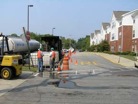Remediation Trends, Treatability Study Services
Bench-Scale Treatability Testing
 Treatability studies provide a low cost evaluation for the development of site- specific chemistries for remediation of heavy metals and organics. Well-designed treatability studies can identify better reagent choices at lower doses that result in cost savings and reduced risk of treatment failure. With a treatability study, chemistries are designed for specific site conditions, and allow for evaluating alternate treatment scenarios and land use options.
Treatability studies provide a low cost evaluation for the development of site- specific chemistries for remediation of heavy metals and organics. Well-designed treatability studies can identify better reagent choices at lower doses that result in cost savings and reduced risk of treatment failure. With a treatability study, chemistries are designed for specific site conditions, and allow for evaluating alternate treatment scenarios and land use options.
Treatability Study Approach
- Assess project goals
- Site-specific study design
- Sampling design and support
- Evaluate remedial alternatives
- Measure long term stability
In-Field Confirmation Testing
Testing services comparable to treatability tests can also be used during the full-scale implementation of a remedy in order to provide “real time” confirmation of success:
- Saving time and money, and potentially
- Optimizing reagent doses, reducing treatment costs
Bench and Field Laboratory Services
The ReSolution Partners treatability study laboratory can provide batch and column studies for metals stabilization, total oxidant demand determination, and organics oxidation. Our experienced staff develop innovative, site-specific test protocols and chemistries designed to meet project goals. Screening indicators are often determined during bench-scale studies that can be measured during full-scale implementation to evaluate treatment performance.
 Testing Capabilities
Testing Capabilities
-Leaching extraction screenings including:
- Toxicity Characteristic Leaching
- Procedure (TCLP)
- Synthetic Precipitation Leaching Procedure (SPLP)
- California Waste Extraction Test (WET)
- Multiple Extraction Procedure (MEP)
- In-vitro Relative Bioavailability Leaching Procedure (RBALP
- Project-specific extractants such as site groundwater
-Total Oxidant Demand (TOD) determination on solid and aqueous samples for:
-Colorimetry analysis for:
- Fluoride
- Metals: Aluminum, Cadmium, Hexavalent Chromium, Cobalt, Copper, Iron, Lead, Nickel, Zinc
- Nitrogen: Ammonia, Nitrate, Nitrite
- Permanganate
- Phosphorus, Reactive
- Potassium
- Sulfate
- 10 ug/L reporting
-Total persulfate analysis on solid and aqueous samples by titration.
-Organics oxidation destruction efficiency in soil (total and leachable) and in groundwater.
-Selected total ion analyses on aqueous samples by Ion Specific Electrode (ISE) methods.
-Alkalinity Neutralization Capacity / Calcium Carbonate Equivalent (ANC/CCE) determination for solid and aqueous samples.
-Total moisture in solids determination
-pH determination for solid and aqueous samples







